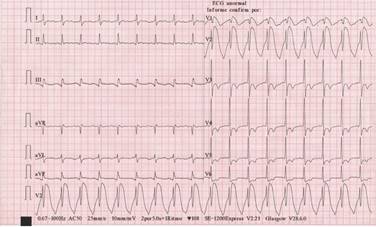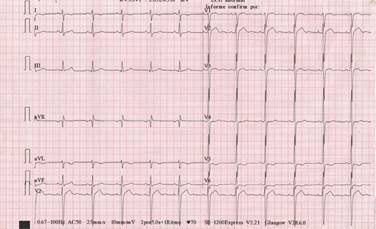Clinical cases
Brugada phenocopy induced by aluminum phosphide intoxication: a case
report
Fenocopia de Brugada inducida por intoxicación con fosfuro de
aluminio: reporte de un caso
José Alejandro Gómez-Godinez1
Romeo Josué Tereta-Sunuc1
Rodolfo Gutiérrez-Bartlett1
Gustavo Adolfo Sotomora-Ricci1
Fabio Enrique Parada-Cabrera1
*
1 Cardiology unit, Hospital Roosevelt,
Guatemala, Guatemala.
Abstract:
Introduction:
Brugada phenocopy is an electrocardiographic phenomenon that presents a type
1 or 2 Brugada pattern triggered by various underlying clinical
conditions.
Case report:
a 23-year-old male patient was admitted due to the ingestion of aluminum
phosphide. At admission, an electrocardiogram showed a Brugada type 1
pattern with a transthoracic echocardiogram showing a left ventricular
ejection fraction of 34% and apical dyskinesia. A second electrocardiogram
was performed 24 hours later with sinus tachycardia and no evidence of the
Brugada pattern. After 72 hours of clinical improvement, the apical
contractility was reported as normal.
Conclusion:
this acute stress-induced cardiomyopathy by Aluminum phosphide intoxication
met the criteria to be regarded as a type 1 class B Brugada phenocopy.
Keywords: Brugada; phenocopy; aluminum; phosphide; intoxication
Resumen:
Introducción:
la fenocopia de Brugada es un fenómeno electrocardiográfico que presenta un
patrón de Brugada tipo 1 o tipo 2 desencadenado por diversas condiciones
clínicas subyacentes.
Caso clínico:
paciente masculino de 23 años que ingresó por ingesta de fosfuro de
aluminio. Al ingreso, el electrocardiograma mostró patrón de Brugada tipo 1
con un ecocardiograma transtorácico que mostró una fracción de eyección del
ventrículo izquierdo del 34% y discinesia apical. Se realizó un segundo
electrocardiograma 24 horas después con taquicardia sinusal y sin evidencia
del patrón de Brugada. Luego de 72 horas de mejoría clínica se reportó la
contractilidad apical como normal.
Conclusión:
esta miocardiopatía aguda inducida por estrés por intoxicación con fosfuro
de aluminio cumplió con los criterios para ser considerada como fenocopia de
Brugada tipo 1 clase B.
Palabras clave: Brugada; fenocopia; aluminio; fosfuro; intoxicación
Introduction
Brugada phenocopy is an electrocardiographic phenomenon characterized by presenting a
type 1 or 2 Brugada pattern triggered by various underlying clinical conditions that
resemble the Brugada phenotype in an individual not carrying the genetic
mutation.1 This case highlights
the fact that the search for Brugada phenocopies triggering factors remains open,
and the list continues to grow, confirming the importance of timely recognition of
Brugada phenocopies and their clinical approach.
Case presentation
A 23-year-old male patient was admitted due to the intentional ingestion of a Tablet
with 1.7 grams of aluminum phosphide and 1.3 grams of excipients. An
electrocardiogram (ECG) was performed (Figure
1). The patient was admitted with neurologic deficit and shock;
cardiovascular support, mechanical ventilation, and vasopressors were initiated.
Cardiac biomarkers (troponin I, brain natriuretic peptide) were elevated beyond the
99th percentile values at admission; no electrolyte imbalance was present when the
ECG was taken; a transthoracic echocardiogram was performed, documenting a 34%
biplane left ventricular ejection fraction (LVEF) with apical dyskinesia. A second
ECG was performed 24 hours later, showing sinus tachycardia without evidence of the
Brugada pattern (Figure 2). After 72 hours of
admission, vasopressors were discontinued, and the patient was weaned from
mechanical ventilation. A second transthoracic echocardiogram showed improvement in
systolic function (LVEF 48% by biplane) without alterations in apical contractility.
In a 24-hour Holter, the Brugada pattern was not documented again. Due to the
patient’s age and contractility improvement, the patient was not considered in need
of coronary angiography. Acute stress-induced (tako-tsubo)
cardiomyopathy was presumed. The patient continued to show clinical improvement
until discharged.
Discussion
Aluminum phosphide (Alp) is used to preserve grains worldwide. It is also one of the
most dreaded poisons. The poisoning mechanism after ingestion of Alp is thought to
be secondary to the release of phosphine gas by a chemical reaction of the phosphide
with water and hydrochloric acid in the stomach.2 Phosphine is a metabolic poison that noncompetitively
blocks cytochrome C oxidase in rat liver preparation.3 It also boosts the extra-mitochondrial release of
oxygen free radicals, resulting in lipid peroxidation and protein denaturation of
the cell membrane.4
A cardinal feature of Alp poisoning is early hypotension (within six hours) with a
clear mental state. Features of shock include a thready pulse, cold extremities,
sweating, and oliguria present in 70% of patients.5 Myocardial injury is common with global hypokinesia of
the left ventricle and interventricular septum with decreased LVEF on
echocardiography, which occurs during the first 1 to 4 days in up to 50% cases.6 Apical dyskinesia was not found in
Alp poisoning in previous reports. In this case, it was attributed to
tako-tsubo cardiomyopathy.
In Alp intoxication nonsurvivors, examination of myocardial tissue has been reported
with focal areas of congestion, necrosis, and edema along with inflammatory cell
infiltration; histopathological changes related to left ventricular dysfunction have
been reported.
The ECG may show the following:
Widening of QRS complex.4
ST depression.
ST elevation.
T inversion in V2 and V3.
Arrhythmias and conduction disturbances include atrial fibrillation,
ventricular tachycardia, wandering atrial pacemaker, complete heart
block, bundle branch block, and sinus arrest.7
Asymmetrical T-wave inversion in precordial leads was attributed to the acute
stress-induced cardiomyopathy found in the patient.
Previous cases of Brugada phenocopy induced by intoxication by Alp have been
reported, none of them in conjunction with acute stress-induced cardiomyopathy.8,9
The diagnostic criteria for Brugada phenocopy have been established (The first four
criteria are mandatory):
ECG pattern with type 1 or type 2 Brugada morphologic criteria.
Presence of an underlying condition that is identifiable and
reversible.
Resolution of the ECG pattern upon elimination of the underlying
condition.
Low pretest probability for Brugada syndrome determined by the lack of
symptoms, clinical history, and family history.
A provocative negative test with a sodium channel blocker drug (e.g.,
ajmaline, flecainide, or procainamide).
A negative genetic test.1
Conclusions
This acute stress-induced cardiomyopathy by Aluminum phosphide intoxication met the
criteria to be considered a type 1 class B Brugada phenocopy according to the
Morphologic classification system from the international registry of Brugada
phenocopies.
References
1. Baranchuk A, Nguyen T, Ryu MH, Femenía F, Zareba W, Wilde AAM et
al. Brugada phenocopy: new terminology and proposed classification: Brugada
phenocopy. Ann Noninvasive Electrocardiol. 2012; 17 (4): 299-314. Available in:
https://pubmed.ncbi.nlm.nih.gov/23094876/
[ Links ]
2. Moghadamnia AA. An update on toxicology of aluminum phosphide.
Daru. 2012; 20 (1): 25. Available in: https://pubmed.ncbi.nlm.nih.gov/23351193/
[ Links ]
3. Chefurka W, Kashi KP, Bond EJ. The effect of phosphine on
electron transport in mitochondria. Pestic Biochem Physiol. 1976; 6 (1): 65-84.
Available in: https://www.sciencedirect.com/science/article/pii/0048357576900109
[ Links ]
4. Mehrpour O, Jafarzadeh M, Abdollahi M. A systematic review of
aluminium phosphide poisoning. Arh Hig Rada Toksikol. 2012; 63 (1): 61-73.
Available in: https://pubmed.ncbi.nlm.nih.gov/22450207/
[ Links ]
5. Khosla SN, Nand N, Kumar P. Cardiovascular complications of
aluminum phosphide poisoning. Angiology. 1988; 39 (4): 355-359. Available in:
http://dx.doi.org/10.1177/000331978803900404
[ Links ]
6. Bajaj R, Wasir HS, Agarwal R, Malhotra A, Chopra P, Bhatia ML.
Aluminum phosphide poisoning: Clinical toxicity and outcome in eleven
intensively monitored patients. Natl Med J India. 1988; 1:
270-274.
[ Links ]
7. Katira R, Elhence GP, Mehrotra ML, Srivastava SS, Mitra A,
Agarwala R et al. A study of aluminum phosphide (AlP) poisoning with special
reference to electrocardiographic changes. J Assoc Physicians India. 1990; 38
(7): 471-473.
[ Links ]
8. Devinder S, Jang B, Singh RK. Brugada type ecg pattern in a case
of aluminium phosphide poisoning. Journal of Evolution of Medical and Dental
Sciences. 2012; 1 (6): 932-935.
[ Links ]
9. Anselm DD, Evans JM, Baranchuk A. Brugada phenocopy: a new
electrocardiogram phenomenon. World J Cardiol. 2014; 6 (3): 81-86. Available in:
http://dx.doi.org/10.4330/wjc.v6.i3.81
[ Links ]











 nueva página del texto (beta)
nueva página del texto (beta)




